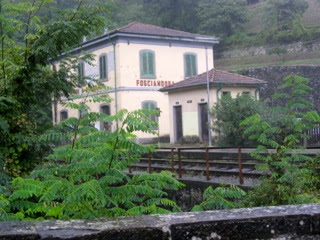Sniffing out the best
 |
| Spot the dog |
 |
| A Lagotto Romagnolo, or truffle hound |
Every October there are festivals all over the Garfagnana to celebrate not only truffles but also those other, more affordable fungi found in the dense forests of the region - porcini mushrooms. The harvesting and sale of mushrooms is tightly regulated in Italy, both to protect stocks and to try to reduce accidental poisoning. (Some 40,000 people suffer mushroom poisoning every year in the country.)
Anyone wishing to gather mushrooms on land they do not own themselves is required to buy a permit and is also required to take a test to show knowledge of the poisonous varieties. There is a limit to the amount of mushrooms gathered, the days on which they can be gathered and also the manner in which they are collected. Baskets only, to allow the spores to be distributed through the chestnut forests - no paper or plastic bags allowed. The redoubtable Claudio, down at the bar/restaurant Il Ponte di Ceserana, is the official provider of the permits for mushroom gathering in the Fosciandora commune.
 |
| Porcini from the fores |
I ask Alina if Francesco will be out mushroom gathering now that the drought has broken. She tells me that according to local tradition, it takes 13 days after the first serious rain of the autumn before the mushrooms are worth gathering. Too late for us this year. So I buy 100gm of the local dried porcini from a shop in Castelnuovo di Garfagnana, to enhance a risotto, enrich an omelette or transform a slow cooked leg of lamb and bring back sunny memories of Italy on dark days in London.
Slow cooked lamb with porcini and white wine
(based on a Waitrose recipe)
Leg of lamb
large onion, roughly chopped
two cloves of garlic, cut in slivers
lemon thyme sprigs
300 ml white wine
40 gm dried porcini
250 gm fresh chestnut mushrooms, halved or quartered
2 tablespoons creme fraiche
seasoning
Pour warm water over the porcini to cover and leave to soak whilst preparing the meat. Cut small slits in the lamb and push in slivers of garlic. Season with salt and pepper and sear all over in hot oil in a frying pan. Put on one side, and fry the chopped onions in the same pan until soft and coloured. Put the onions into a slow cooker or ordinary casserole dish, add four or five sprigs of lemon thyme and top with the leg of lamb. Deglaze the frying pan with the white wine, add the porcini with their soaking liquid, bring to a bubble and pour over the meat and vegetables. Either cook in the oven at Gas Mark 4 (180 degrees) for 2.5 hours or leave in the slow cooker and go off for a long walk, write the chapter of a novel, or catch up with your Italian homework (Alina is offering to teach me by Skype).
When the meat is cooked, keep warm on a carving plate. Reduce the sauce by half over a high heat, then stir in the chestnut mushrooms and simmer for 5 minutes. Stir in the creme fraiche and heat gently, test seasoning. Carve the lamb, and serve the mushrooms and sauce separately. Good accompaniments are potato and celeriac puree, or grilled polenta, with green beans.






